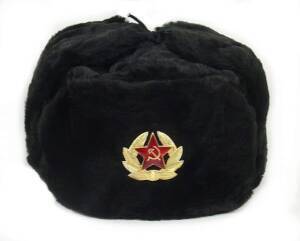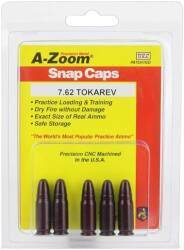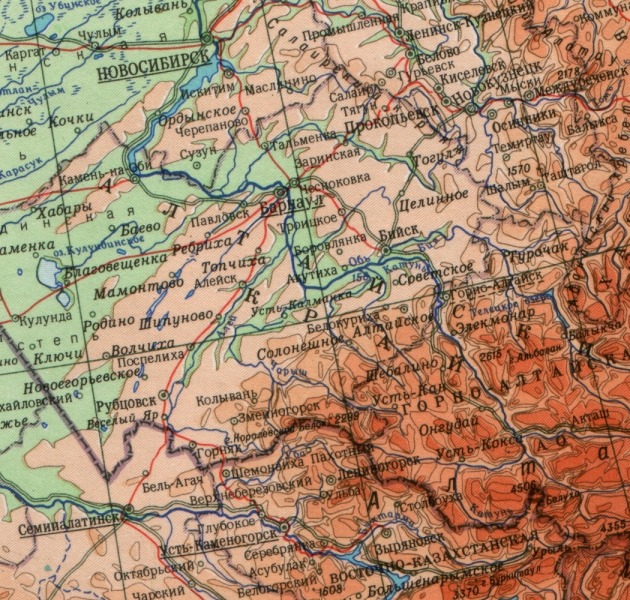
9x18mm Makarov
The 9x18mm Makarov Cartridge
The 9x18mm Makarov cartridge was the standard military pistol cartridge of the Soviet Union and Warsaw Pact following the Second World War. It played a role similar to that of the 9x19mm Parabellum round in NATO. Many of those countries still use it. Let's learn about its history, its technical characteristics, and what the various Russian-language ammunition labels mean.
Origins of the 9x18mm Cartridge
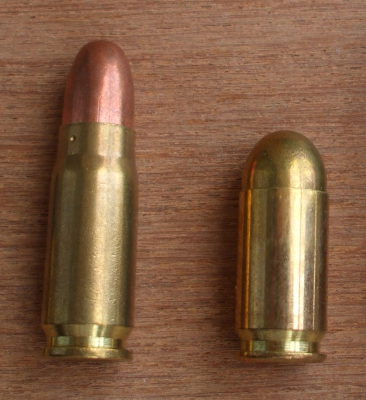
Left: 7.62x25 mm Tokorev
Right: 9x18 mm Makarov
The 7.62x25 Tokorev cartridge was developed in 1930 as an enhanced version of the 7.63x25mm Mauser cartridge. It was based on the Mauser round but it's intentionally just a little bit different. Security through incompatability.
For example, the Tsarist Russian empire built its rail network based on a 1524 mm (or 5 feet) gauge rather than the 1435 mm (or 4 ft 8 1/2 in) gauge currently used in western Europe, the Middle East, China, Australia, and North America. It's unclear exactly why. This may have been done simply for the increased stability of a wider gauge, and a 5-foot gauge was in common use in the southern U.S. when the Russian rail network was first being constructed. However, the increased difficulty of invading across a break-of-gauge may have played a factor. Finland and the Baltic nations used the Russian rail gauge, but Finland was a Russian Grand Duchy and the other nations were under Russian control.
Soviet military doctrine, however, explicitly required designs using ammunition incompatible with that of likely adversaries. This would prevent an invading army from using captured Soviet ammunition.
I have taken two NRA courses,
one for rifles and another for handguns.
The instructor in both of those strongly emphasized the
importance of owning a pistol firing the 9x19mm Parabellum
round.
This was to prepare for when (not if, but when)
the U.S. is invaded by foreign military forces,
and the U.S. military, supposedly the best in the world,
is easily defeated and needs to be rescued by untrained
and unorganized citizens, you can just pick up and use
the ammunition left lying around by the invaders.
This assumes that NATO will to be the first to invade the US,
although that's not the craziest part of this theory.
The Tokarev TT-30 pistol was adopted in January of 1931, and with minor changes it became the Tokarev TT-33, the Soviet Union's standard service pistol from 1933 until the mid 1960s. These fired the 7.62x25mm round. That cartridge was also used in the Czech ČZ-52 pistol and a number of submachine guns including the Soviet PPD-40, PPSh-41, and PPS-43 among several others.
The Red Army experienced some problems with the TT-33 during World War II, and a new pistol design was wanted. The TT-33 short recoil action was very similar to John Browning's design for the U.S. M1911. A simpler direct blowback system was wanted, as it would be easier to manufacture and potentially more accurate. The new pistol design should be lighter, including its ammunition load. The result was the 9x18mm Makarov round.
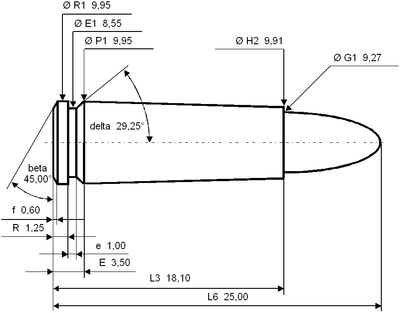
9x18mm Makarov cartridge diagram.
The 9x18mm Cartridge
B.V. Semin designed the cartridge in 1946, basing it on the German 9x18mm Ultra and the 9x17mm (or .380 ACP) cartridge used by the Walther PP. Two years later, in 1948, Nikolay Fyodorovich Makarov designed the pistol which came to be called the Makarov PM and which gave Semin's cartridge the rest of its name. Other Warsaw Pact pistols including the Hungarian FÉG PA-63 were soon designed to use the cartridge.
The doctrinally required incompatability comes from differences in the cartridge case and bullet dimensions. 9x18mm Makarov bullets are 9.27mm in diameter, while 9x19mm Parabellum bullets are 9.017mm.
Here are two boxes of 9x18mm Makarov ammunition, one from Bear and one from Sellier & Bellot.
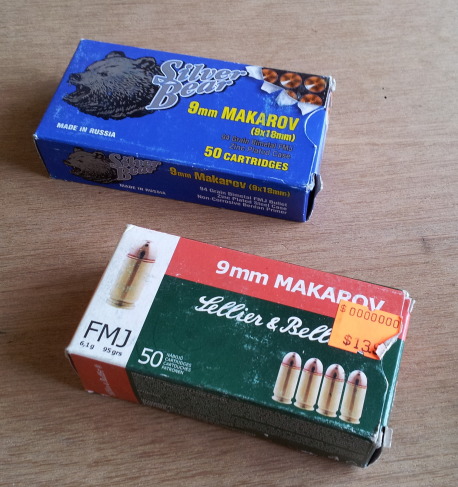
Sellier & Bellot was founded by Louis Sellier, a French merchant, in 1825. He established a factory in Prague where he manufactured percussion caps for Francis I, the Emperor of Austria. Fellow Frenchman Jean Maria Nicolaus Bellot soon joined the company. By 1830 they were a major ammunition manufacturer for European and overseas markets. By 1837 they were manufacturing 156 million percussion caps per year.
Ammunition technology advanced, and in 1870 they began manufacturing cartridges. The new country of Czechoslovakia was formed by the treaties ending World War I, and Sillier & Bellot became the main supplier of handgun ammunition for the Czechoslovak Army and police.
Sellier & Bellot is now based in Vlašim, Czech Republic. They were acquired by the Brazilian company CBC, Companhia Brasileira de Cartuchos, in 2009. CBC, based in São Paulo, is now one of the world's largest ammunition manufacturers.
Bear is made at the CJSC Barnaul Cartridge Plant in the city of Барнаул (or Barnaul), an important industrial center producing a lot of heavy machinery, tires and furniture.
Barnaul is well to the west of the Ural Mountains in southern Siberia. It's the administrative center of Altai Krai, near Russia's borders with Kazakhstan, China, and Mongolia. See the yellow cross on this map.
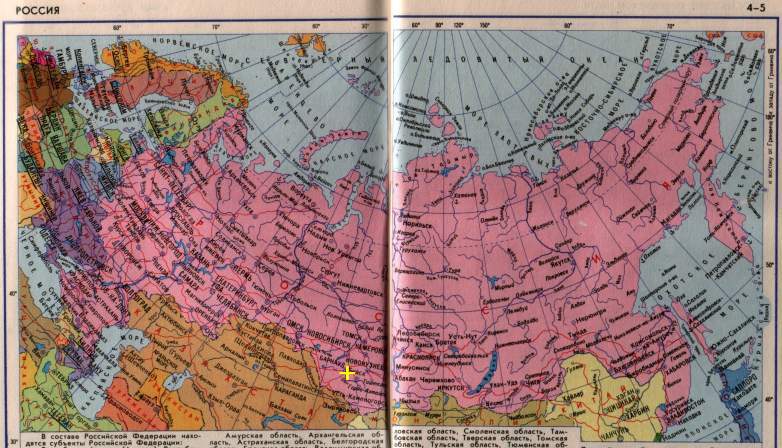
In this more detailed map you see the city along the Ob River as it comes down out of the Altai mountains south of Novosibirsk. Look for Барнаул on the map.
Bear's cartridge cases are made from aluminum. The case is the most expensive component of the round, and using aluminum rather than brass significantly reduces the cost.
However, aluminum cases cannot be reloaded.
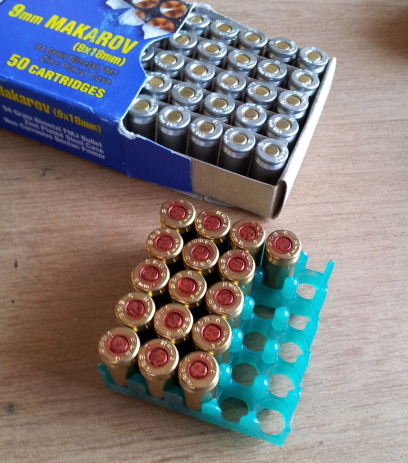
Notice the headstamps.
Sellier & Bellot: S & B / 9 mm M
Bear: 9 mm Mak with the CJSC Barnaul emblem.
The Sellier & Bellot primers are sealed with red lacquer. The solvents used for cleaning and the lighter lubricants used for maintaining guns can damage cartridges, causing failures to fire. Even more dangerous than a complete failure to fire is a delayed ignition. The worst case scenario would be that it ignites only after you have opened the chamber to extract the failed round.
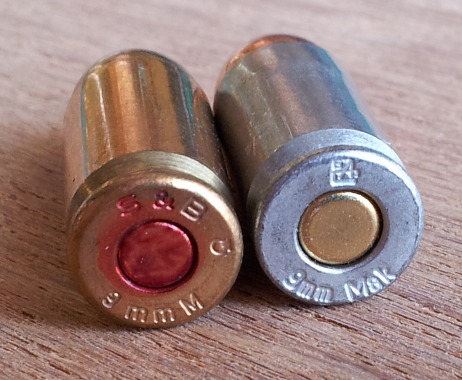
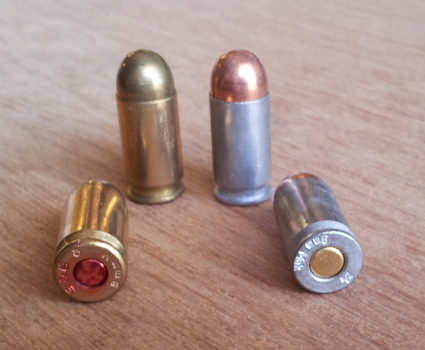
Soviet / Russian Infantry Ammunition Designations
The Ministry of Defense of the Soviet Union, which evolved into the Ministry of Defense of Russia, had a Main Artillery Directorate which later became the Main Rocketry-Artillery Directorate. These were the initial Главное Артиллерийское Управление (ГАУ) and later Главное Ракетно-Артиллерийское Управление, (ГРАУ) what we English speakers would spell and abbreviate Glavnoye Artilleriyskoye Upravleniye (GAU) and Glavnoye Rocketno-Artilleriyskoye Upravleniye (GRAU).
The GAU/GRAU maintains "indices", tables of military standards, for many categories of military equipment. So-called GAU "Division 56" is for infantry weapons and "Division 57" is for infantry ammunition. 57-N is the main category for infantry ammunition. With the update to GRAU, 56 and 57 became 6 and 7, respectively.
| Division 56 | ||
| Cyrillic | Latin | Category |
| 56-А | 56-A | automatic and semi-automatic firearms |
| 56-В | 56-V | rifles, shotguns |
| 56-Г | 56-G | grenade launchers, mortars |
| 56-Ж | 56-Zh | shops, vessels |
| 56-ЖЛ | 56-ZhL | cartridge box (Ammo in strips) |
| 56-ЗТ | 56-ZT | anti-aircraft guns |
| 56-И | 56-I | tools and accessories |
| 56-ИП | 56-IP | Kits military calibers |
| 56-Л | 56-L | Cartridge Tape |
| 56-М | 56-M | Stores |
| 56-Н | 56-N | autoloading pistols and revolvers |
| 56-П | 56-P | guns |
| 56-Р | 56-R | machine guns |
| 56-Т | 56-T | machines |
| 56-У | 56-U | Position |
| 56-Х | 56-Kh | edged weapons |
| 56-Ч | 56-Ch | auxiliary elements |
| 56-Ш | 56-Sh | bags, belts, holsters, cases |
| 56-Ю | 56-Yu | Accessories |
| 56-ЮЛ | 56-YuL | snaryazhatelnye (stuffing) machines |
| 56-Я | 56-Ya | capping (boxes) for infantry weapons |
| Division 57 | ||
| Cyrillic | Latin | Category |
| 57-Б | 57-B | cartridges with armor-piercing bullets |
| 57-БЗ | 57-BZ | cartridges with armor-piercing incendiary bullets |
| 57-БЗТ | 57-BZT | cartridges with armor-piercing incendiary tracer bullets |
| 57-БТ | 57-BT | cartridges with armor-piercing tracer bullets |
| 57-Г | 57-G | hand grenades |
| 57-ГК | 57-GK | jet cumulative (anti) grenades |
| 57-ГО | 57-GO | jet fragmentation grenades |
| 57-ГУ | 57-GU | training grenades |
| 57-Д | 57-D | cartridges with long-range (heavy) bullets |
| 57-Ж | 57-Zh | fuses for grenades |
| 57-З | 57-Z | cartridges with incendiary bullets |
| 57-ЗП | 57-ZP | cartridges with incendiary bullets sighting |
| 57-К | 57-K | caps |
| 57-Н | 57-N | cartridges with normal bullets |
| 57-О | 57-O | clips |
| 57-П | 57-P | cartridges with sighting bullets |
| 57-СД | 57-SD | signal cartridges for day action |
| 57-СН | 57-SN | signal cartridges for night action |
| 57-Т | 57-T | cartridges with tracer bullets |
| 57-У | 57-U | special ammunition or high pressure with power charge |
| 57-Х | 57-Kh | blanks |
| 57-Ч | 57-Ch | training ammunition |
| 57-Я | 57-Ya | capping (boxes) for ammunition |
Not all of the 9x18mm cartridge types have had GAU/GRAU designations, but this table attempts to list all the variants.
| Type | GAU/GRAU | Description | ||
| Cyrillic | Latin | Cyrillic | Latin | |
| 9 П гж (гл) | 9 P GZh (GL) | 57-Н-181 | 57-N-181 | 6.1 gram bullet with lead core, brass case, 10.7 gram cartridge |
| 9 Пст гж (гс, гл) | 9 PST GZh (GS, GL) | 57-Н-181С | 57-N-181S | 5.9 gram bullet with steel core, bimetal sleeve case |
| 9 ППТ гж | 9 PPT GZh | 57-Т-181 | 57-T-181 | Tracer bullet, issued from factory NCA in Novosibirsk |
| 9 БЖТ гж | 9 BZhT GZh | 7Н15 | 7N15 | Steel armor-piercing bullet, muzzle velocity 325 m/s |
| 9 СП7 гж | 9 SP7 GZh | Expanding bullet with high stopping power developed at order of KGB in late 1970s and early 1980s. Bullet weight 4.2 grams, muzzle velocity 405-420 m/s | ||
| 9 СП8 гж | 9 SP8 GZh | Frangible (low-penetration) bullet for anti-terrorist operations and aboard aircraft. Bullet weight 5.0 grams, muzzle velocity 250-255 m/s | ||
| 9 Ппэ гж | 9 PPE GZh | Explosive bullet, developed in early 1990s | ||
| 9x18 РГ028 гж | 9x18 RG028 GZh | Frangible expanding bullet | ||
| 9x18 ПС гс ППО | 9x18 PS gs PPO | Standard law enforcement round. 6.3 gram bullet, 330 m/s muzzle velocity, 330-343 J muzzle energy | ||
| 9x18 ПРС гс | 9x18 PRS gs | Standard law enforcement round. | ||
| 9x18 ПСВ | 9x18 PSV | Hollow-point bullet, sold on export market. Bullet weight 7.3-7.8 grams, cartridge 10.68-11.63 grams, 280-305 m/s at 10 meter range. | ||
| 9x18 ПСО гж | 9x18 PSO gzh | Sport-hunting cartridge. Bullet weight 6.1 grams, muzzle velocity 290-315 m/s | ||
| 9 УЧ | 9 UCh | 57-Н-181УЧ | 57-N-181UCh | Inert training cartridge |
| 9x18mm ПБМ | 9x18mm PBM | 7Н25 | 7N25 | Armor-piercing round. Semi-jacketed hardened steel core bullet, 3.7 grams, muzzle velocity 519 m/s. Pierces 5 mm steel plates, 2.4 mm armor plus Kevlar. |
| 9x18mm ПММ | 9x18mm PMM | 57-Н-181СМ, 7Н16 | 57-N-181CM, 7N16 | Upgrade of 9x18mm PM round with increased penetration. Bullet 5.54-5.8 grams, muzzle velocity 410-435 m/s. Bullet shape designed to minimize ricochets. steel core bullet, 3.7 grams, muzzle velocity 519 m/s. Pierces 5 mm steel plates, 2.4 mm armor plus Kevlar. |
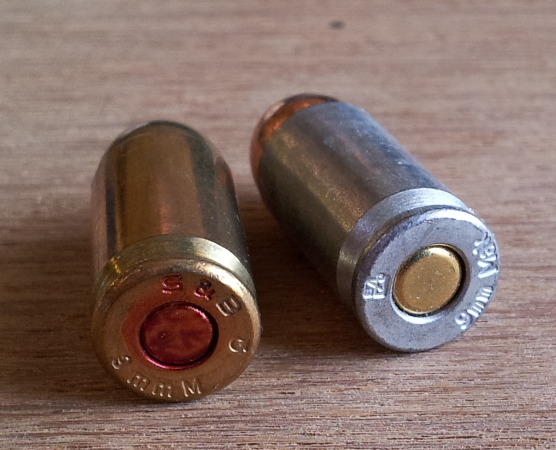
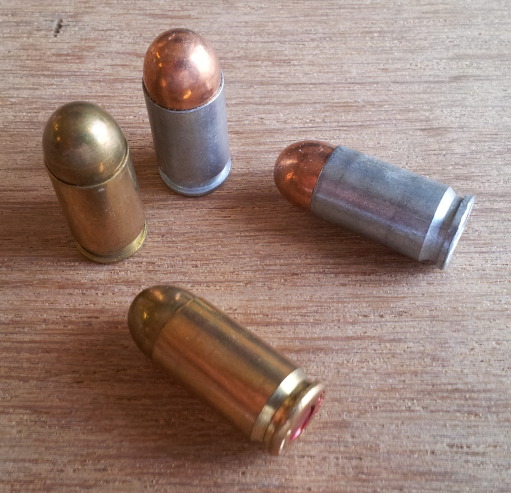
More about the 9x18mm Makarov and Russian Ammunition
Now that you know about 9x18mm Makarov ammunition,
you probably would like to know about a gun that uses it.
Or possibly you need to know how to read Russian
military surplus ammunition labels.
Hungarian
FÉG PA-63
Pistol
How to
field strip the
FÉG PA-63
Decoding Russian
Military Surplus
Ammunition Labels
7.62x39mm
Ammunition
7.62x54mmR
Ammunition
